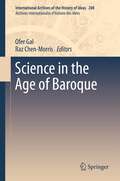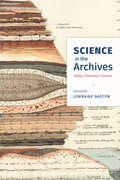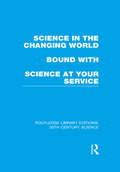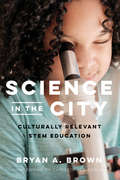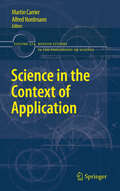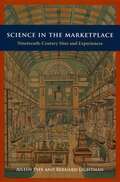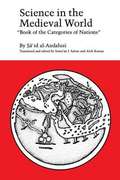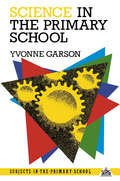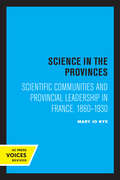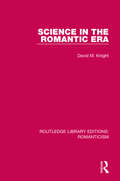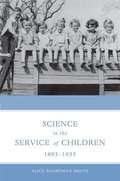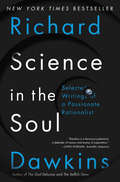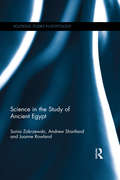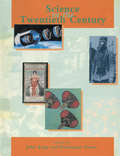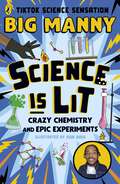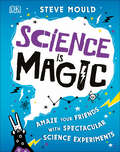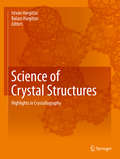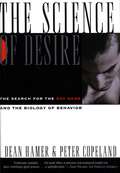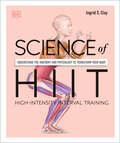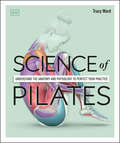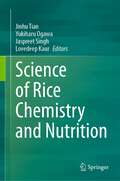- Table View
- List View
Science in the Age of Baroque (International Archives of the History of Ideas Archives internationales d'histoire des idées #208)
by Ofer Gal Raz Chen-MorrisThis volume examines the New Science of the 17th century in the context of Baroque culture, analysing its emergence as an integral part of the high culture of the period. The collected essays explore themes common to the new practices of knowledge production and the rapidly changing culture surrounding them, as well as the obsessions, anxieties and aspirations they share, such as the foundations of order, the power and peril of mediation and the conflation of the natural and the artificial. The essays also take on the historiographical issues involved: the characterization of culture in general and culture of knowledge in particular; the use of generalizations like 'Baroque' and the status of such categories; and the role of these in untangling the historical complexities of the tumultuous 17th century. The canonical protagonists of the 'Scientific Revolution' are considered, and so are some obscure and suppressed figures: Galileo side by side with Scheiner;Torricelli together with Kircher; Newton as well as Scilla. The coupling of Baroque and Science defies both the still-triumphalist historiographies of the Scientific Revolution and the slight embarrassment that the Baroque represents for most cultural-national histories of Western Europe. It signals a methodological interest in tensions and dilemmas rather than self-affirming narratives of success and failure, and provides an opportunity for reflective critique of our historical categories which is valuable in its own right.
Science in the Archives: Pasts, Presents, Futures
by Lorraine DastonArchives bring to mind rooms filled with old papers and dusty artifacts. But for scientists, the detritus of the past can be a treasure trove of material vital to present and future research: fossils collected by geologists; data banks assembled by geneticists; weather diaries trawled by climate scientists; libraries visited by historians. These are the vital collections, assembled and maintained over decades, centuries, and even millennia, which define the sciences of the archives. With Science in the Archives, Lorraine Daston and her co-authors offer the first study of the important role that these archives play in the natural and human sciences. Reaching across disciplines and centuries, contributors cover episodes in the history of astronomy, geology, genetics, philology, climatology, medicine, and more—as well as fundamental practices such as collecting, retrieval, and data mining. Chapters cover topics ranging from doxology in Greco-Roman Antiquity to NSA surveillance techniques of the twenty-first century. Thoroughly exploring the practices, politics, economics, and potential of the sciences of the archives, this volume reveals the essential historical dimension of the sciences, while also adding a much-needed long-term perspective to contemporary debates over the uses of Big Data in science.
Science in the Changing World bound with Science at Your Service (Routledge Library Editions: 20th Century Science)
by VariousScience in the Changing World, first published in 1933, contains a series of broadcasted presentations on the relationship between science and the development of European civilisation in the first half of the 20th century. Specifically, each talk attempts to reflect the crisis through which the world seemed to be passing at the time, and to make an analysis of those forces of transformation in science, art, economics, and social life which were associated most closely with the advent of the ‘scientific’ century. Included among the presenters are such eminent and diverse thinkers as Julian Huxley, Bertrand Russell and Hilaire Belloc. Science at Your Service: First published in 1945, this collection of twelve BBC broadcasts focuses on the influence of science in everyday life, and demonstrates that not all science is remote and theoretical. Each speaker deals with some aspect of mid-20th century scientific advance as it related to subjects of practical importance, from textiles and tunnels to fishing and ship design. Offering a glimpse into the attitudes towards science current in the middle of the Second World War, this brief and accessible collection will be of interest to cultural historians as well as to the general science enthusiast.
Science in the City: Culturally Relevant STEM Education (Race and Education)
by Bryan A. Brown2021 Outstanding Book Award, American Association of Colleges for Teacher Education (AACTE)Science in the City examines how language and culture matter for effective science teaching. Author Bryan A. Brown argues that, given the realities of our multilingual and multicultural society, teachers must truly understand how issues of culture intersect with the fundamental principles of learning. This book links an exploration of contemporary research on urban science teaching to a more generative instructional approach in which students develop mastery by discussing science in culturally meaningful ways. The book starts with a trenchant analysis of the &“black tax,&” a double standard at work in science language and classrooms that forces students of color to appropriate and express their science knowledge solely in ways that accord with the dominant culture and knowledge regime. Because we are in an interactive, multimedia world, the author also posits the necessity of applying what is known about best practices in science teaching to best practices in technology. The book then turns to instruction, illustrating how science education can flourish if it is connected to students&’ backgrounds, identities, language, and culture. In this empowered—and inclusive—form of science classroom, the role of narrative is key: educators use stories and anecdotes to induct students into the realm of scientific thinking; introduce big ideas in easy, familiar terms; and prioritize explanation over mastery of symbolic systems. The result is a classroom that showcases how the use of more familiar, culturally relevant modes of communication can pave the way for improved science learning.
Science in the Context of Application
by Martin Carrier Alfred NordmannWe increasingly view the world around us as a product of science and technology. Accordingly, we have begun to appreciate that science does not take its problems only from nature and then produces technological applications, but that the very problems of scientific research themselves are generated by science and technology. Simultaneously, problems like global warming, the toxicology of nanoparticles, or the use of renewable energies are constituted by many factors that interact with great complexity. Science in the context of application is challenged to gain new understanding and control of such complexity--it cannot seek shelter in the ivory tower or simply pursue its internal quest for understanding and gradual improvement of grand theories. Science in the Context of Application will identify, explore and assess these changes. Part I considers the "Changing Conditions of Scientific Research" and part II "Science, Values, and Society". Examples are drawn from pharmaceutical research, the information sciences, simulation modelling, nanotechnology, cancer research, the effects of commercialization, and many other fields. The book assembles papers from well-known European and American Science Studies scholars like Bernadette Bensaude-Vincent, Janet Kourany, Michael Mahoney, Margaret Morrison, Hans-Jörg Rheinberger, Arie Rip, Dan Sarewitz, Peter Weingart, and others. The individual chapters are written to address anyone who is concerned about the role of contemporary science in society, including scientists, philosophers, and policy makers.
Science in the Early Years: Building Firm Foundations from Birth to Five
by Pat Brunton Linda C ThorntonGiving early years practitioners and students the confidence to effectively support scientific exploration and investigation with young children, this book explains the science behind young children's knowledge and understanding of the world. Linking theory to good early years practice, the emphasis throughout the book is on recognizing young children as competent, creative thinkers and building on their ideas. The reader is encouraged to think carefully about the role of the adult in supporting child-initiated learning and discovery by providing open ended resources, asking productive questions and observing carefully. The authors provide essential background information for all the key areas of scientific knowledge supported by practical ideas suitable for babies, toddlers and children aged 3 to 5 years. For each of these ideas, practice and theory are linked by highlighting the skills, attitudes and dispositions to observe and the questions to ask to challenge young children's thinking and plan for the next stages in their learning. Chapters cover: - the place of science in early years curricula in the UK - the processes of science and the role of the adult in supporting young children's scientific learning - using open ended resources to create a science-rich environment - essential background knowledge, covering all areas of early years science - ideas to use as starting points for exploration and investigation, indoors and outdoors - pointers for observational assessment and planning - suppliers of resources and equipment By making clear links to practice, and providing ideas to use with babies and toddlers as well as with 3-5 year old children, this book enables the reader to fully exploit the potential for exploration and investigation in any early years setting. Pat Brunton and Linda Thornton are both Education Consultants based in Cheltenham. They run their own training and consultancy company alc associates, and edit Early Years Update.
Science in the Making: Volume Four - 1950-1998
by E. A. DavisDuring its 200-year history, the Philosophical Magazine was transformed from a journal that published papers on all aspects of science to one that specialised in physics and more latterly in condensed matter. From 1950 it became a journal of choice for electron microscopists and in this fourth and last volume of the series, appear classic papers by
Science in the Marketplace: Nineteenth-Century Sites and Experiences
by Bernard Lightman Aileen FyfeThe nineteenth century was an age of transformation in science, when scientists were rewarded for their startling new discoveries with increased social status and authority. But it was also a time when ordinary people from across the social spectrum were given the opportunity to participate in science, for education, entertainment, or both. In Victorian Britain science could be encountered in myriad forms and in countless locations: in panoramic shows, exhibitions, and galleries; in city museums and country houses; in popular lectures; and even in domestic conversations that revolved around the latest books and periodicals. Science in the Marketplace reveals this other side of Victorian scientific life by placing the sciences in the wider cultural marketplace, ultimately showing that the creation of new sites and audiences was just as crucial to the growing public interest in science as were the scientists themselves. By focusing attention on the scientific audience, as opposed to the scientific community or self-styled popularizers, Science in the Marketplace ably links larger societal changes—in literacy, in industrial technologies, and in leisure—to the evolution of “popular science. ”
Science in the Media: Popular Images and Public Perceptions
by Paul R Brewer Barbara L LeyThis timely and accessible text shows how portrayals of science in popular media—including television, movies, and social media—influence public attitudes around messages from the scientific community, affect the kinds of research that receive support, and inform perceptions of who can become a scientist. The book builds on theories of cultivation, priming, framing, and media models while drawing on years of content analyses, national surveys, and experiments. A wide variety of media genres—from Hollywood blockbusters and prime-time television shows to cable news channels and satirical comedy programs, science documentaries and children’s cartoons to Facebook posts and YouTube videos—are explored with rigorous social science research and an engaging, accessible style. Case studies on climate change, vaccines, genetically modified foods, evolution, space exploration, and forensic DNA testing are presented alongside reflections on media stereotypes and disparities in terms of gender, race, and other social identities. Science in the Media illuminates how scientists and media producers can bridge gaps between the scientific community and the public, foster engagement with science, and promote an inclusive vision of science, while also highlighting how readers themselves can become more active and critical consumers of media messages about science. Science in the Media serves as a supplemental text for courses in science communication and media studies, and will be of interest to anyone concerned with publicly engaged science.
Science in the Medieval World: "Book of the Categories of Nations"
by Sa`id al-Andalusi Sema`an I. SalemDuring the Middle Ages, a thriving center for learning and research was Muslim Spain, where students gathered to consult Arabic manuscripts of earlier scientific works and study with famous teachers. One of these teachers was Sa'id al-Andalusi, who in 1068 wrote Kitab Tabaqat al-'Umam, or "Book of the Categories of Nations," which recorded the contributions to science of all known nations. Today, it is one of few surviving medieval Spanish Muslim texts, and this is its first English translation.
Science in the Primary School (Subjects in the Primary School)
by Yvonne GarsonUsing practical examples and case studies the author examines some of the experimental and investigative teaching methods which are intended to support the 'specialist approach' in the teaching of primary science.
Science in the Provinces: Scientific Communities and Provincial Leadership in France, 1860 - 1930
by Mary Jo NyeThis title is part of UC Press's Voices Revived program, which commemorates University of California Press’s mission to seek out and cultivate the brightest minds and give them voice, reach, and impact. Drawing on a backlist dating to 1893, Voices Revived makes high-quality, peer-reviewed scholarship accessible once again using print-on-demand technology. This title was originally published in 1986.
Science in the Romantic Era (Routledge Library Editions: Romanticism #Vol. 615)
by David KnightFirst published in 1998. The Romantic Era was a time when society, religion and other beliefs, and science were all in flux. The idea that the universe was a great clock, and that men were little clocks, all built by a divine watchmaker, was giving way to a more dynamic and pantheistic way of thinking. A new language was invented for chemistry, replacing metaphor with algebra; and scientific illustration came to play the role of a visual language, deeply involved with theory. A scientific community came gradually into being as the 19th century wore on. The papers which compose this book have appeared in a wide range of books and journals; together with the new introduction they illuminate science and its context in the Romantic Era and follow its effects in the 19th century.
Science in the Service of Children, 1893-1935
by Alice Boardman Smuts Robert W. Smuts R. Malcolm Smuts Barbara B. Smuts P. Lindsay Chase-LansdaleThis book is the first comprehensive history of the development of child study during the early part of the twentieth century. Most nineteenth-century scientists deemed children unsuitable subjects for study, and parents were hostile to the idea. But by 1935, the study of the child was a thriving scientific and professional field. Here, Alice Boardman Smuts shows how interrelated movements-social and scientific-combined to transform the study of the child. Drawing on nationwide archives and extensive interviews with child study pioneers, Smuts recounts the role of social reformers, philanthropists, and progressive scientists who established new institutions with new ways of studying children. Part history of science and part social history, this book describes a fascinating era when the normal child was studied for the first time, a child guidance movement emerged, and the newly created federal Children's Bureau conducted pathbreaking sociological studies of children.
Science in the Soul: Selected Writings of a Passionate Rationalist
by Richard DawkinsThe legendary biologist and bestselling author mounts a timely and passionate defense of science and clear thinking with this career-spanning collection of essays, including twenty pieces published in the United States for the first time. For decades, Richard Dawkins has been a brilliant scientific communicator, consistently illuminating the wonders of nature and attacking faulty logic. Science in the Soul brings together forty-two essays, polemics, and paeans—all written with Dawkins’s characteristic erudition, remorseless wit, and unjaded awe of the natural world. Though it spans three decades, this book couldn’t be more timely or more urgent. Elected officials have opened the floodgates to prejudices that have for half a century been unacceptable or at least undercover. In a passionate introduction, Dawkins calls on us to insist that reason take center stage and that gut feelings, even when they don’t represent the stirred dark waters of xenophobia, misogyny, or other blind prejudice, should stay out of the voting booth. And in the essays themselves, newly annotated by the author, he investigates a number of issues, including the importance of empirical evidence, and decries bad science, religion in the schools, and climate-change deniers. Dawkins has equal ardor for “the sacred truth of nature” and renders here with typical virtuosity the glories and complexities of the natural world. Woven into an exploration of the vastness of geological time, for instance, is the peculiar history of the giant tortoises and the sea turtles—whose journeys between water and land tell us a deeper story about evolution. At this moment, when so many highly placed people still question the fact of evolution, Dawkins asks what Darwin would make of his own legacy—“a mixture of exhilaration and exasperation”—and celebrates science as possessing many of religion’s virtues—“explanation, consolation, and uplift”—without its detriments of superstition and prejudice. In a world grown irrational and hostile to facts, Science in the Soul is an essential collection by an indispensable author.Advance praise for Science in the Soul “The illumination of Richard Dawkins’s incisive thinking on the intellectual world extends far beyond biology. What a treat to see so clearly how matter and meaning fit together, from fiction to philosophy to molecular biology, in one unified vision!”—Daniel C. Dennett, author of From Bacteria to Bach and Back: The Evolution of Minds “I thank Thor and Zeus that in their infinite wisdom they chose to make the great wordsmith of our age a great rationalist, and vice versa.”—Matt Ridley, author of The Evolution of Everything: How New Ideas Emerge “In this golden age of enlightened science writing, it is stunning that no scientist has won the Nobel Prize for Literature. It is time literature’s highest award be granted to a scientist whose writings have changed not just science but society. No living scientist is more deserving of such recognition than Richard Dawkins. . . . Science in the Soul is the perfect embodiment of Nobel–quality literature.”—Michael Shermer, publisher of Skeptic magazine, columnist for Scientific American, and author of The Moral Arc: How Science Makes Us Better People “Science in the Soul is packed with Dr. Dawkins’s philosophy, humor, anger, and quiet wisdom, leading the reader gently but firmly to inevitable conclusions that edify and educate.”—James Randi, author of The Faith Healers
Science in the Study of Ancient Egypt (Routledge Studies in Egyptology)
by Sonia Zakrzewski Andrew Shortland Joanne RowlandScience in the Study of Ancient Egypt takes an innovative and integrated approach to the use of scientific techniques and methodologies within the study of ancient Egypt. Accessibly demonstrating how to integrate scientific methodologies into Egyptology broadly, and in Egyptian archaeology in particular, this volume will help to maximise the amount of information that can be obtained within a study of ancient Egypt, be it in the field, museum, or laboratory. Using a range of case studies which exemplify best practice within Egyptian archaeological science, Science in the Study of Ancient Egypt presents both the scientific methods of analysis available and their potential applications to Egyptologists. Although Egyptology has mainly shown a marked lack of engagement with recent archaeological science, the authors illustrate the inclusive but varied nature of the scientific archaeology which is now being undertaken, demonstrating how new analytical techniques can develop greater understanding of Egyptian data.
Science in the Twentieth Century (Routledge World Reference Ser.)
by John Krige Dominique PestreWith over forty chapters, written by leading scholars, this comprehensive volume represents the best work in America, Europe, and Asia. Geographical diversity of the authors is reflected in the different perspectives devoted to the subject, and all major disciplinary developments are covered.There are also sections concerning the countries that have made the most significant contributions, the relationship between science and industry, the importance of instrumentation, and the cultural influence of scientific modes of thought. Students and professionals will come to appreciate how, and why, science has developed - as with any other human activity, it is subject to the dynamics of society and politics.
Science is Lit: Crazy chemistry and epic experiments with TikTok science sensation BIG MANNY
by Big MannyAlright BOOM, Big Manny is here to show you how you can become a real-life scientist and create awesome experiments at home using ordinary ingredients.We'll learn some basic (and not-so basic) chemistry tings - from combustion to chromatography (chroma-what-now?).We'll meet the amazing elements that each have their own personalities - from fiery hydrogen to the main man oxygen.And we'll create explosive reactions - from fizzing mixtures to dish soap volcanoes!Let's start experimenting and find out why science is lit, innit.Written by TikTok science sensation Big Manny, this is the perfect book to inspire young scientists aged 8–12.
Science is Magic: Amaze Your Friends With Spectacular Science Experiments
by Steve MouldPacked with over 40 magical science tricks for kids using simple experiments! Join comedian and author Steve Mould, #1 bestselling author of How to be a Scientist, and learn the secrets behind some of the most famous magic tricks and illusions (and learn some of your own). Learn how to bend water with a balloon, turn water into juice, make a glass beaker disappear in oil, and wow your friends with levitating tinsel! Packed with optical illusions, pranks, and fun facts, this ebook is a must-have for any aspiring scientist or magician (the two aren't as different as you might think)!Each trick is explained using step-by-step photographs, and the science behind each one is showcased clearly and simply. Sprinkled throughout the ebook are profiles of famous magicians and illusionists, such as Harry Houdini and David Blaine, and stories of how they used science to create their most famous tricks.Science is Magic is the perfect addition to any family bookshelf or classroom, putting a fresh spin on science for kids. What's fantastic about this kids&’ activity ebook is that many of the magic tricks or experiments are something you learn to perform on a friend and require practice. Thus, (the genius bit) it&’s not something kids will just do once and then turn the page.Think Magic Is Just An Illusion? Think again! Discover science - REAL magic at your fingertips. Learn some amazing experiments to wow your friends, find out how magicians use science in their most famous tricks, and discover the magic of the world around you. Packed with activities for kids from magic tricks to optical illusions, and peppered with fascinating facts, this educational ebook is a must-have for scientists and magicians alike. Added bonus, each &‘trick&’ or experiment in the ebook uses simple items that can be grabbed from home or a hardware store. Get ready to wow your friends with some cool science-backed magic like:- Magnetic fingers- Reading minds- Color changing potion- Guess the coin- Floating ping pong ball and much more! Add other fun-filled Steve Mould titles in the DK collection to your bookshelves, like How To Be A Scientist and The Bacteria Book.
Science of Crystal Structures
by Istvan Hargittai Balazs HargittaiA volume which includes entries on quasicrystals, icosahedral packing, other packing considerations, extended structures, data treatment and data mining is presented by luminaries from the crystallography community. Several of the contributions are from the schools of such trend-setting crystallographers as J. Desmond Bernal and Aleksandr I. Kitaigorodskii. Internationally renowned scientists contributed such as Tom L. Blundell, Johann Jacob Burckhardt, John L. Finney, Jenny P. Glusker, Nobel laureate Herbert A. Hauptman, the 2014 Ewald-Prize winner A. Janner, Aminoff-Prize winner Isabella Karle, Nobel laureate Jerome Karle, Buckley-Prize winner Alan L. Mackay, Ewald-Prize winner David Sayre, Vladimir Shevchenko, and J. Fraser Stoddart. A few frontier topics dominate the selected material. Pioneers of the direct methods describe the phase problem and how it was solved, including the mathematical approach and the utilization of experience with gas-phase electron diffraction. The reviews by Herbert Hauptman, Jerome and Isabella Karle, and David Sayre reach to the present day in assessing the possibilities of X-ray crystallography. Another focus topic is the investigation of systems that are outside the so-called classical system of crystals. They include quasicrystals, imperfect and very small crystals, supramolecular species, crystal structures without lattice, clusters, nanomaterials among others. Application of synchrotron and cryoprotection techniques, the free-electron laser flash technique and others are mentioned in addition to X-ray crystallography. The relationship between structural and materials properties are examined and uncovered. The broader topics of the so-called generalized crystallography include polymers, clusters, polydisperse chain assemblies, and giant icosahedral fullerenes. There are some key contributions related to the structural investigation of biological macromolecules.
Science of Desire: The Gay Gene and the Biology of Behavior
by Dean HamerA compelling behind-the-scenes look at cutting-edge scientific inquiry, as well as a brilliant examination of the ramifications of genetic research, The Science of Desire is a lasting resource in the increasingly significant debate over the role that genetics plays in our lives.In July 1993, a scientific event made front-page news: the discovery that genetics plays a significant role in determining homosexuality. In The Science of Desire, Dean Hamer—the scientist behind the groundbreaking study—tells the inside story of how the discovery was made and what it means, not only for our understanding of sexuality, but for human behavior in general. In this accessible and remarkably clear book, Dean Hamer expands on the account of his history-making research to explore the scientific, social, and ethical issues raised by his findings. Dr. Hamer addresses such tough questions as whether it would be possible or ethical to test in utero for the gay gene; whether genetic manipulation could or should be used to alter a person's sexuality; and how a gay gene could have survived evolution. A compelling behind-the-scenes look at cutting-edge scientific inquiry, as well as a brilliant examination of the ramifications of genetic research, The Science of Desire is a lasting resource in the increasingly significant debate over the role that genetics plays in our lives.
Science of Fungi in Grapevine
by Olivier Viret Katia GindroThis open access book provides a comprehensive exploration of the relationship between fungi and grapevines, covering contemporary mycological classifications, pathogens, the mycobiome, endophytes, and mycorrhizae. Inspired by the French book "La Vigne, Maladies Fongiques" by the same authors, which won first prize at the 2015 OIV book competition (Organisation Internationale de la Vigne et du Vin, Dijon), this work aims to extend and update that foundational text. The introduction delves into the origins and adaptability of grapevines in response to evolving fungal diseases, alongside an overview of their biology, epidemiology, and control measures. The second chapter covers the systematics of the genus Vitis, the developmental stages of the vine, the anatomy of various organs, the history and breeding of resistant varieties, and the natural defense mechanisms of grapevines against fungal infections. A significant portion of the book provides the latest insights into mycology, including chapters on fungal systematics and taxonomy, as well as the concepts of holobiome, microbiome, and mycobiome in relation to grapevines. The third part focuses on fungal diseases affecting green organs, wood, and roots, illustrated at macroscopic, microscopic, and ultrastructural levels, and includes discussions on disease cycles and epidemiology. Additionally, there is a chapter dedicated to grafting systems and the specificity of fungi in nurseries. The final chapter addresses the control of fungal diseases, from historical perspectives to modern chemical groups of active ingredients, natural fungicides, and comprehensive disease management strategies. This includes application techniques, calibration of spraying equipment, drift reduction, and proper storage and handling of fungicides. This open access book serves as a key reference on the complex interactions between fungi and grapevines for scientists, students, and winegrowers, offering extensive practical knowledge and a rich scientific background based on over thirteen years of research by the authors.
Science of HIIT: Understand the Anatomy and Physiology to Transform Your Body
by Ingrid S. ClayTrain your way to a leaner, stronger body in half the time or less!Get ready to break a serious sweat with this scientific guide to HIIT training! Discover everything you need to know to achieve the best results from your HIIT workouts by understanding the muscle action needed to perfect each exercise.Inside the pages of this fitness book, you&’ll explore the physiology of more than 90 essential HIIT exercises! It is packed with: • Specially commissioned CGI artworks depicting all the main HIIT resistance exercises — from burpees to plank jacks — and variations that add or reduce the challenge. • CGI artwork features color-coding to highlight how the muscles, ligaments and joints engage, stretch and relax to perform each exercise. • Training programs, tailored to different abilities and goals, provide suggested workouts with a progressive increase in challenges over weeks and months. • Easy-to-follow infographics help explain the hard science behind why HIIT training is so efficient, and what beneficial physical adaptations it can bring. High-intensity interval training is a fantastic way to lose weight and get strong by performing very short bursts of targeted exercise. Recent scientific research shows that HIIT is the most efficient form of exercise for raising fitness levels and increasing cardio-respiratory health. Science of HIIT reveals the facts to help you optimize the benefits of HITT to your body and mind.The clear CGI artwork details the mechanics of each exercise, correct body posture, the muscles involved and how they engage to perform movements. You&’ll also learn the knowledge and tools needed to be able to create your own bespoke workouts. This HIIT guide will completely transform your performance and help you smash your goals!DK Publishing&’s Science of series helps readers discover the research and scientific theories behind exercise and sport. It&’s perfect for training at home or the gym. Other sport science books in this series include Science of Yoga and Science of Strength Training.
Science of Pilates: Understand the Anatomy and Physiology to Perfect Your Practice (DK Science of)
by Tracy WardExplore the science behind over 50 pilates exercises to master each movement with confidence and control. DK brings you a ground-breaking health book that will help you revitalize your workouts and perfect your Pilates practice, by understanding the muscle action, breathwork and techniques required, every step of the way. Did you know that performing Pilates can strengthen your core, improve flexibility and posture, and help to reduce stress and anxiety at the same time? Backed by scientific research, learn how Pilates exercises benefit every system in the body. Science of Pilates reveals the facts with annotated artworks that show the mechanics, the angles, how your blood flow and respiration are affected, the key muscle and joint actions working below the surface of each exercise, safe alignment, and much more!Go on a journey of self-discovery to explore: - Specially commissioned CGI artworks depict all the main Pilates exercises with variations that add or reduce challenge. - Artworks detail the mechanics of each exercise, correct body posture, the muscles involved and how they engage to perform movements.- Illustrations featuring color-coding to highlight how the muscles, ligaments, and joints engage, stretch, and relax to perform each exercise.- Pilates programs tailored to different abilities and aims.- Suggested practices with a progressive increase in challenge over weeks and months.- Easy-to-follow infographics help explain the hard science behind why Pilates training is so effective and what beneficial physical adaptations it can bring.Set out to unearth the facts behind the pseudo-science fads, The Science of Pilates is an approachable, entertaining and easy-to read fitness guide for those seeking self-development backed up by solid scientific evidence. The popular question and answer format brings immediacy to the information provided, and the highly visually illustrations truly bring the science to life in a contemporary and accessible way. At DK, we believe in the power of discovery. So why stop there? If you like Science of Pilates, then why not try Science of Yoga to help you better understand yoga anatomy in order to perfect your practice and poses, or Science of Strength Training to support you in your journey to build you strongest body. Complete the collection today!
Science of Rice Chemistry and Nutrition
by Jaspreet Singh Jinhu Tian Yukiharu Ogawa Lovedeep KaurThis book presents the knowledge of rice chemistry and nutrition. It includes identification, analysis, and application of bioactive chemical components of rice, the starch digestibility after pre-treatment, domestic cooking or processing, and the structure changes at multiple scales during processing and digestion. The novel application of rice starch, protein, polyphenols, dietary fiber, and the next generation of healthy rice products is summarized and the underline mechanisms of starch digestion are also revealed. Particularly, the advanced technologies for the fortification of rice nutrition as well as the challenges for the future rice processing industry are also included. This book provides the most recent research progresses and the state-of-the-art technologies regarding rice nutrition & chemistry to students, researchers, and technologists who are interested in rice and the fields of food science, nutrition, and food engineering.
